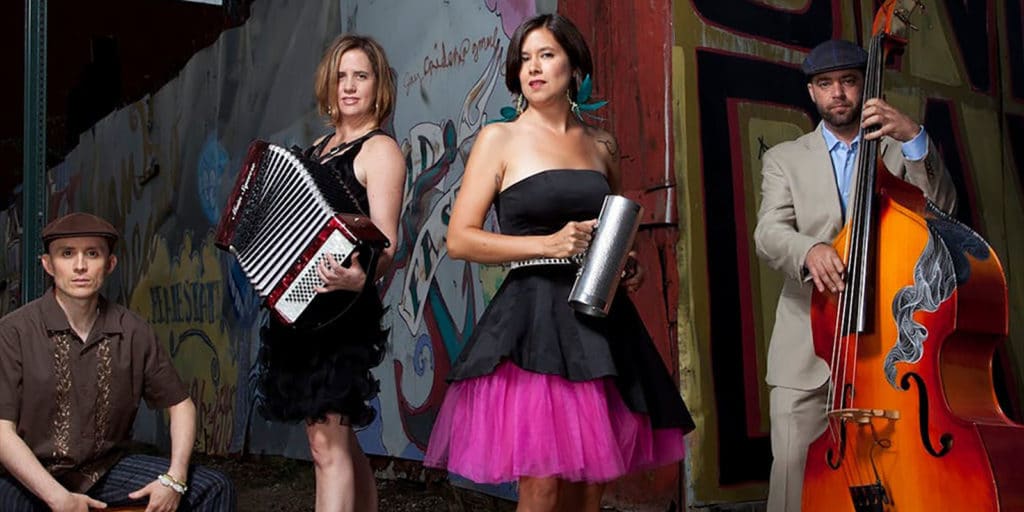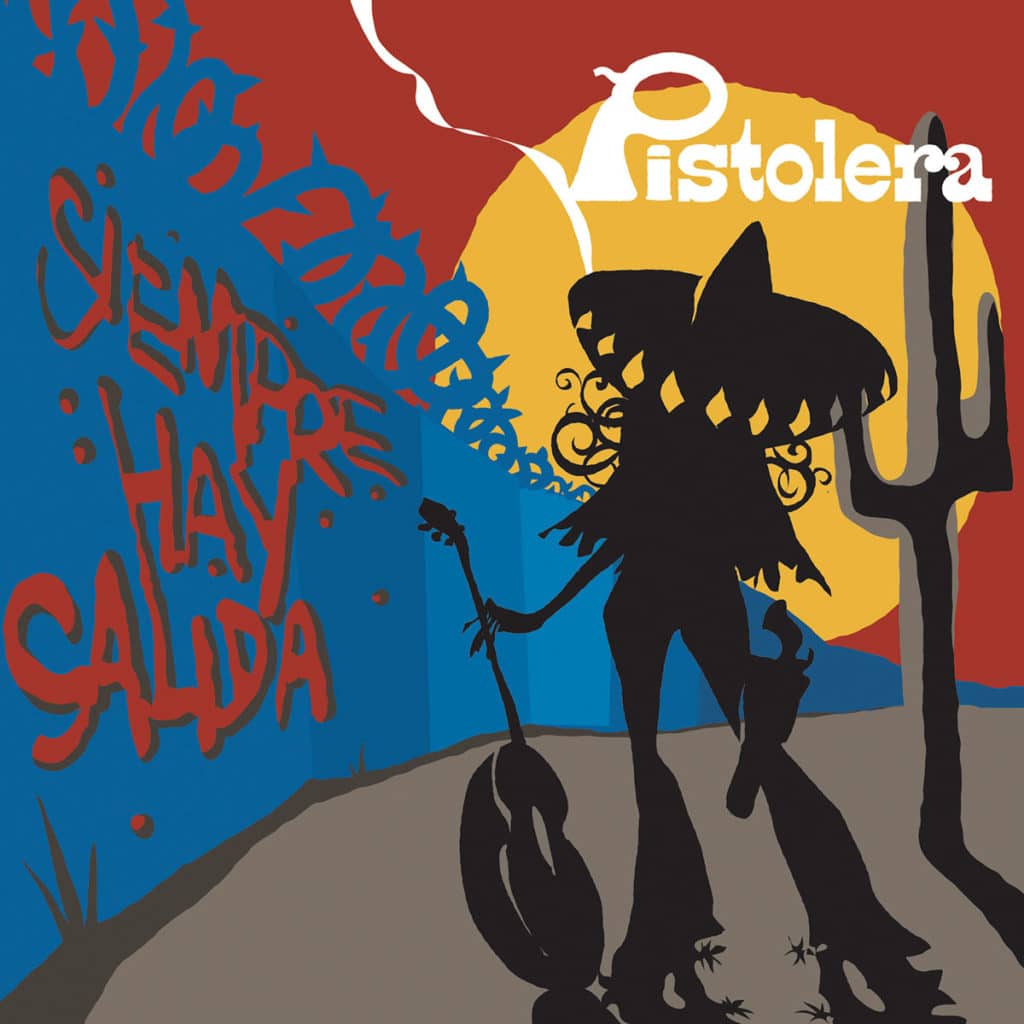Pistolera is a great Latin Alternative, Mexican-American border band from Brooklyn, of course.
Carnegie Hall Citywide at Flushing Town Hall
Friday, February 14, 2020 ~ Pistolera plays a Valentine’s Day concert of Latin alternative for Carnegie Hall Citywide at Flushing Town Hall in Flushing, Queens at 8pm. Free with RSVP (these shows sell out) to flushingtownhall.org
Wear your dance shoes, and bring that sparkle in your eye. It’s Valentine’s Day. You never know what might happen.
Pistolera, The Band

A “pistolera” is Mexican Spanish for a woman gunslinger. The band is actually named after the comic book character “Pistolera” who after fighting Batman a few times joined an all-female group of mercenaries.
- Sandra Lilia Velasquez on vocals and guitar.
- Maria Elena on accordion.
- Inca B. Satz on bass.
- Sebastian Guerrero on drums.
Singer-songwriter Sandra Lilia Velasquez grew up near the border in San Diego, California. Her mom was a lawyer who used to send her teenage daughter to help undocumented workers with their paperwork. Velasquez has a music degree from Cal Arts and studied drumming and dancing in Cuba.
Pistolera Albums
- El Desierto y la Ciudad (2011)
- En Este Camino (2008)
- Siempre Hay Salida (2006)
The Silence of the Desert is Loaded
Listening to the range of Pistolera’s music made us go back and review the Latin Grammy categories for Regional Mexican music, the most popular Latin music in the United States.
Mexico is a big, diverse country with many musical influences, a border that has moved several times, and people that used to move freely back and forth across it.
There has always been a lot of mixing going in. Mexican-American, American-Mexican, Texican, Southwesterner, whatever. If you can get out of yourself there isn’t really much difference, or at least one that doesn’t wiggle around as much as the border does.
Roughly the western third of our country used to be Mexico. The land was fairly empty so the Mexican government welcomed settlers, many of whom were German, Czech and Polish. They brought along their brass bands, accordions and polka music. Eventually those European immigrants decided to carve off their own country, the Republic of Texas around 1835-36.
The United States thought that was a great idea and cooked up the Mexican-American War of 1846-1848 (some things never change). Upon the discovery of California gold in 1848, Washington quickly settled for a small chunk of Mexico, basically the northern half of the country.
Another little piece was carved off in the Gadsden Purchase of 1854 to open the southern route of the Transcontinental Railroad. So the border kept moving. There’s an old saying in the southwest that, “we didn’t cross the border, the border crossed us.”
Even after the border settled down, there used to be an annual migration like that of the monarch butterfly. We came north to work in the spring, summer and fall, and then returned home to winter in Mexico and spend the holidays with our families. The desert crossing is more dangerous now so we just stay in place.
Anyway there has always been a lot of mixing going on.
Mexico itself is very diverse. The Indigenous music of the great pre-Columbian civilizations of Mexico mixed with Spanish and African traditions during the colonial period of human enslavement. Son Mexicano is the “Mexican sound” just as son Cubano is the “Cuban sound.”
But it’s not only son Mexicano. Around the Mexican Caribbean city of Veracruz, there is son jarocho. On the western side of Mexico, around Jalisco, there is son jaliscenses which later became ranchera/mariachi. There is also son huasteco, son calentano, son michoacano and so on from different regions.
All these regional forms of the Mexican sound mixed with the Germanic brass bands, accordions and polkas of the Texans into what we now call Regional Mexican. The brass bands became Mexican Banda. Son jaliscenses became Ranchera. It is often played by Mariachi dressed in their fancy Charro horseman outfits.
The oom-pa accordion bands became Norteño (northern). North of the border in the 1990s, Norteño became Tejano with a more electric sound. Norteño and Tejano are basically the same thing. Norteño from south of the border sounds more old-timey. Tejano sounds more modern.
People dance the Texas two-step to all of this. That’s country dancing in the United States. The Marlboro man in advertising and movies may have been European-American, but back in the day cowboys were Mexican and Black.
Colombian Cumbia is popular in Mexico too. Colombian musicians popularized the African-Indigenous sound when they immigrated to Mexico in the 1950s and 1970s. Colombian Cumbia with its accordion sound may have fit easily into the accordion sounds of Mexico.
So there is an awful lot of mixing going on, on both sides of the border. And Pistolera is all this (except the brass Banda). There are rock influences too. Nowadays it’s called Latin Alternative. That’s the sound of Nacional Records out of Los Angeles who produces the Latin Alternative Music Conference in New York City in summer.
And if you want to mix it up Mexican style around New York City, where do you go? Oy vey. You cross the border to Brooklyn, of course. That’s why Pistolera is a great Latin Alternative, Mexican-American border band from Brooklyn.
When you still yourself in the desert, you start to notice how alive it is. You begin to hear things, some familiar sounds and some that could only come from another world, some other world out there in the moonlight. Sandra Lilia Velasquez is right when she sings in her NPR Tiny Desk Concert, “El silencio del desierto está cargado” (the silence of the desert is loaded).
On lonely desert nights, keep your ears up for the Pistolera. If she comes around, you must get up and dance. And don’t forget to smile.

The original coverage was sponsored by Carnegie Hall Citywide.
